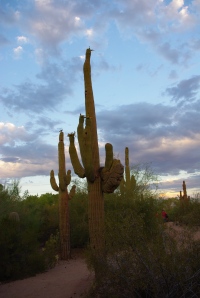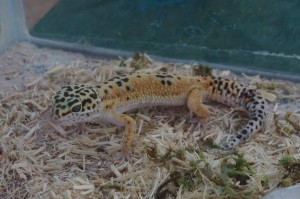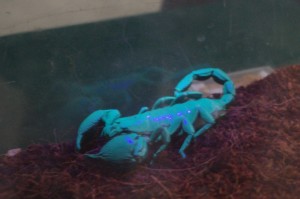Desert Botanical Garden visitors gain a new perspective every Thursday and Saturday night from May 1 through August 28 at the Garden Flashlight Tour. Visitors gather at the Amphitheater after obtaining flashlights from a volunteer. There they participate in a discussion with Pam Levine, a Desert Botanical Garden staff member, about the plants and animals in the garden, how the tour works and the importance of staying hydrated.
After visitors receive maps, they break into groups and volunteers take them to different Flashlight Tour Discovery Stations throughout the Garden. At these stations visitors learn about different plants and creatures. Volunteers give demonstrations and answer questions.
At the saguaro station, a volunteer shows visitors photos of saguaro blooms and explains how Native Americans harvest the fruit for food or how birds eat the fruit and scatter the seeds. He also explains how these plants absorb and retain moisture.
At the gecko and lizard exhibit, a volunteer shows off different local lizards and a leopard gecko from Afghanistan. She tells visitors about each creature and answers everyone’s questions.
At the snake station, Paul, a volunteer, holds a California king snake and encourages visitors to pet him going in the direction of his scales. A nonvenomous snake, the king snake eats rattlesnakes with no ill effects as evidenced by a photo displayed at the exhibit.
Penny one of two domesticated desert tortoises greets visitors on the Desert Discovery Trail. Gloria, a volunteer knowledgeable about desert tortoises, says that 12-year-olds Penny and Poppy reside in burrows at the Garden for the preschool children. Gloria explains desert tortoises make the worst mothers because they lay their eggs, cover them up and never see the hatchlings. The federal government protects desert tortoises and if you capture one, it can’t be released back into the wild because of spreading disease to others.
At another station, visitors get to view a tarantula and a black emperor scorpion from North Africa. The volunteer also shows a mounted example of the small, brown Arizona bark scorpion. The volunteer places a black light on the black emperor scorpion, and he glows a vibrant purple in the dark.
Along the trails, night flowers bloom and an Arizona toad hops along the deserted trail.
Even with the heat of the desert nights, plan to take in the Garden Flashlight Tours before they end. They reveal a whole new aspect of the Garden.










Leave a comment
Comments feed for this article